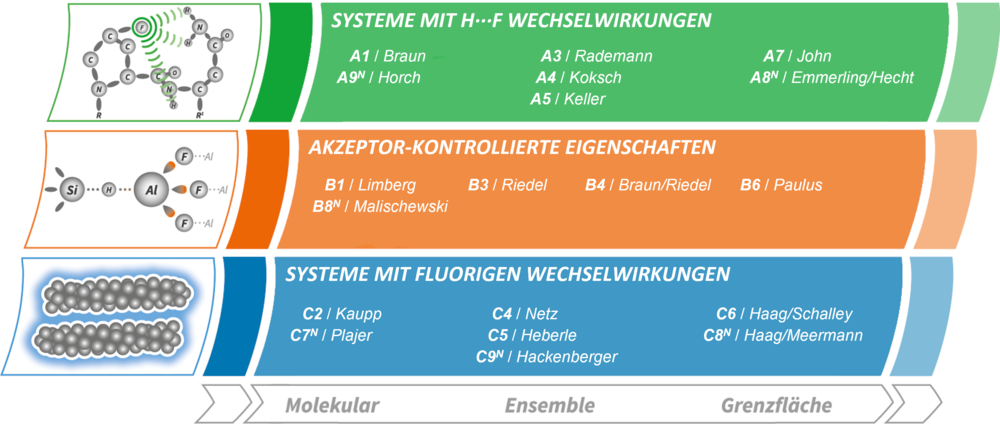Research of the CRC 1349
The purpose of the CRC initiative is to understand and control the complex interactions that can arise from fluorinated building blocks in chemical systems. These phenomena, which are collectively referred to as “Fluorine-Specific Interactions” include H∙∙∙F bonding interactions and networks, acceptor-controlled characteristics, and the interaction between (per)fluorinated alkyl groups, which we call fluorous systems. The interactions on the molecular level differ significantly from those exhibited in bulk systems due to the presence of mutually-influencing, nonadditive effects on surfaces and in liquid phases. As a result, several systems of increasing size are investigated ranging from single molecules through various condensed phase ensembles and up to solid interfaces. The effects of the investigated interactions on a wide range of physicochemical properties and chemical reactivities are in the focus of the CRC. These include the effects of Fluorine-Specific Interactions on the properties of functional materials, their influence on various catalytic processes and the biochemical and pharmacological effects on a range of biological systems. For this purpose, the wide-ranging expertise of the different working groups involved in synthesis/biosynthesis, analytics/spectroscopy and theory/modelling will be complementarily and synergistically linked in order to systematically expand our understanding of both the conceptual underpinning of Fluorine-Specific Interactions and their numerous consequences across many areas of chemistry.
Fluorine-Specific Interactions include interactions in H···F bonding and networks, acceptor-controlled characteristics, and interactions between fluorinated alkyl groups, which we refer to as fluorous systems. Interactions of fluorinated groups with complementary units usually induce new reactivities and properties and can control selectivities. Interactions at the molecular level differ significantly from those in collective, due to mutually influencing – nonadditive – effects at surfaces or in liquid phases.
Subprojects in the strand A|H···F bonds
| A1|Braun | Control of C-F bond activation and fluorination reactions by Fluorine-Specific Interactions in the coordination sphere of metal compounds |
| A3|Rademann | Pentafluorophosphates and other hyperfluorinated fragments as biomimetics of phosphopeptides, phosphoproteins and pyrophosphates |
| A4|Koksch | Controlling protein folding and peptide self-assembly through fluorine-specific interactions |
| A5|Keller | Modeling of Fluorine-Specific Interactions in the protein environment |
| A7|John | Influence of fluoride ions on fluid-melt-mineral interaction in deposit-forming processes |
| A8N|Emmerling /Hecht | Fluorine-Specific Interactions for the detection and reversible immobilization of perfluorinated compounds |
| A9N|Horch | Nonlinear short-duration infrared spectroscopy to characterize Fluorine-Specific Interactions: Structure, dynamics and catalytic determinants of H∙∙∙F networks on fluorido complexes and metallopeptides |
Subprojects in the strand B|acceptor-controlled characteristics
| B1|Limberg | Cooperating Lewis pairs based on fluorine-containing aluminum and bismuth acceptor units |
| B3|Riedel | Fluorine-Specific Interactions starting from F2, HF and F– |
| B4|Braun/Riedel | Fluorinated aluminum compounds as Lewis acids for small molecule activation |
| B6|Paulus | Theoretical investigation of Fluorine-Specific Interactions in condensed metal fluorides and polyfluorine anions |
| B8N|Malischewski | Adjusting the oxidizing power of organic electron acceptors by interacting with fluorinated Brønsted and Lewis acids |
Subprojects in the strand C|fluorous systems
| C2|Kaupp | Quantum-chemical investigations of Fluorine-Specific Interactions: bonding analyses, advanced solvent models, and spectroscopic properties |
| C4|Netz | Microscopic mechanisms of superhydrophobicity and superlubricity of fluorinated surfaces |
| C5|Heberle | Fluorinated Compounds as Vibrational Spectroscopic Interface Sensors |
| C6|Haag/Schalley | Fluorine-Specific Interactions at interfaces |
| C7N|Plajer | Access to degradable perfluorinated polycarbonates via ring-opening polymerization |
| C8N|Haag/Meermann | Evaluation of novel adsorber materials for environmentally relevant perfluorinated compounds |
| 9N|Hackenberger | Fluorine-Specific Interaction for increasing cellular uptake of proteins and drug conjugates into living cells |
